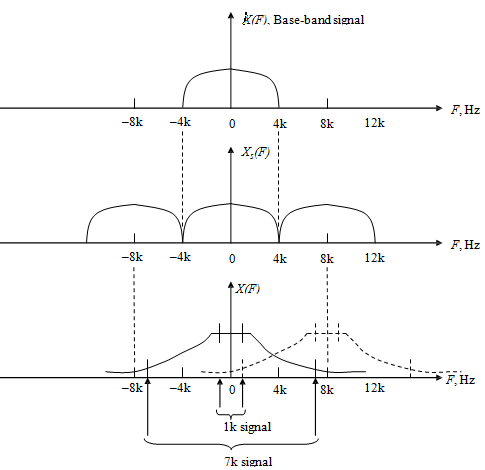The Aliasing Illustration using a signal spectrum band-limited to 4 kHz and the sampling rate of 8 kHz. The signal is completely band-limited to 4 kHz so that there is no overlapping in spectrum of the sampled signal.

The signal has an authentic, desirable, 1 kHz component. As it is not perfectly band-limited to 4 kHz it has another genuine but undesirable 7 kHz component. Because of the first pair of replicas (centered at 8 kHz and -8 kHz) this 7kHz component seems as if it were a 1kHz component - or we can say that the 7 kHz component is an alias of 1kHz. Therefore the first alias of the 1 kHz frequency can be given by 8 kHz - 1 kHz = 7 kHz.
Because of the second pair of replicas at 16 kHz and -16 kHz the 15k component in original signal appears as if it were a 1k component - it is another alias of 1k. This 2nd alias of the 1 kHz frequency can be given by 16 kHz - 1 kHz = 15 kHz. The next alias is (3 x8 - 1) kHz = 23 kHz.
Generally for any frequency F1 within the base band (in this case the frequency from 0 to 4000 Hz) its aliases can be given by
Alias = kFs - F1, k is an integer > 0
Email based The Aliasing assignment help - The Aliasing homework help at Expertsmind
Are you finding answers for The Aliasing based questions? Ask The Aliasing questions and get answers from qualified and experienced Digital signal processing tutors anytime from anywhere 24x7. We at www.expertsmind.com offer The Aliasing assignment help -The Aliasing homework help and Digital signal processing problem's solution with step by step procedure.
Why Expertsmind for Digital signal processing assignment help service
1. higher degree holder and experienced tutors
2. Punctuality and responsibility of work
3. Quality solution with 100% plagiarism free answers
4. On Time Delivery
5. Privacy of information and details
6. Excellence in solving Digital signal processing queries in excels and word format.
7. Best tutoring assistance 24x7 hours